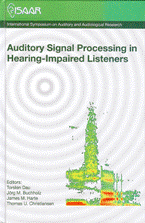Variations in “adequate” own-voice level used by speakers and preferred by listeners when communicating across a distance
Abstract
This paper describes a follow-up study to two pilot experiments on hearing-aid users’ ability to control the level of their own voice. In particular, the role of the so-called intervener in the experiments was examined. The intervener’s task is to supervise the speakers into speaking at the adequate level for the occasion. The study reveals that there are indeed differences among interveners, but that in broad terms the variation among interveners is similar in magnitude to the individual intervener’s test-retest consistency. Also the test-retest consistency of the speakers was examined, and was found to be similar to the aforementioned intervener-variations. The between-speaker variation is about twice as large, though. This suggests that it is highly necessary to include several speakers in experiments on own-voice level control, whereas relying on a single intervener is only mildly problematic.
References
Lane, H. L., and Tranel, B. (1971). “The Lombard sign and the role of hearing in speech,” J. Speech Hear. Res., 14(4), 677-709.
Laugesen, S., Nielsen, C., Maas, P., and Jensen, N.S. (2006). “Effects of amplification variations on vocal level and own-voice sound quality of hearing-aid users,” Podium presentation at IHCON, Lake Tahoe, USA.
Nielsen, C., and Laugesen, S. (2004). “Why own voice is different,” Instructional Course presented at the American Academy of Audiology Convention, Salt Lake City, USA.
Wang, L. M., Rathsam, J., Christensen, C. L., and Rindel, J. H. (2005). “Sound-pressure level distribution in a long, narrow hallway: Measurements versus results from a computer model with scattering from surface roughness and diffraction,” J. Acoust. Soc. Am., 118, 1998.
Additional Files
Published
How to Cite
Issue
Section
License
Authors who publish with this journal agree to the following terms:
a. Authors retain copyright* and grant the journal right of first publication with the work simultaneously licensed under a Creative Commons Attribution License that allows others to share the work with an acknowledgement of the work's authorship and initial publication in this journal.
b. Authors are able to enter into separate, additional contractual arrangements for the non-exclusive distribution of the journal's published version of the work (e.g., post it to an institutional repository or publish it in a book), with an acknowledgement of its initial publication in this journal.
c. Authors are permitted and encouraged to post their work online (e.g., in institutional repositories or on their website) prior to and during the submission process, as it can lead to productive exchanges, as well as earlier and greater citation of published work (See The Effect of Open Access).
*From the 2017 issue onward. The Danavox Jubilee Foundation owns the copyright of all articles published in the 1969-2015 issues. However, authors are still allowed to share the work with an acknowledgement of the work's authorship and initial publication in this journal.


